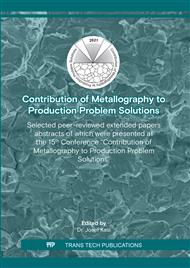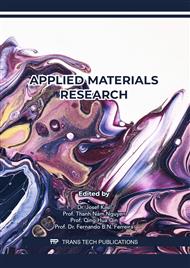[1]
R.Z. Valiev, R.K. Islamgaliev, I.V. Alexandrov, Bulk nanostructured materials from severe plastic deformation, Progr. Mater. Sci. 45 (2000) 103-189.
DOI: 10.1016/s0079-6425(99)00007-9
Google Scholar
[2]
R.Z. Valiev, T.G. Langdon, Achieving exceptional grain refinement through severe plastic deformation: New approaches for improving the processing technology, Metall. Mater. Trans., 42 (2011) 2942-2951.
DOI: 10.1007/s11661-010-0556-0
Google Scholar
[3]
M.B. Ivanov, A.V. Penkin, Yu.R. Kolobov, E.A. Glosov, D. A. Naechaenko, Warm cross-helical rolling in conical rolls as a method of intense plastic deformation, Deformation and destruction of materials 9 (2010) 13-8.
Google Scholar
[4]
V.I. Betekhtin, Yu. R. Kolobov, V. Sklenicka, A.G. Kadomtsev, M.V. Narykova, J. Dvorak, E.V. Golosov, B.K. Kardashev, I.N. Kuzmenko, Effect of a defect structure on the static and long-term strength of submicrocrystalline VT1-0 titanium fabricated by plastic deformation during screw and lengthwise rolling, Tech. Phys. 60 (2015) 66-71.
DOI: 10.1134/s1063784215010041
Google Scholar
[5]
M.B. Ivanov, S.S. Manokhin, D.A. Nechaenko, Yu.R. Kolobov, Features of the crystal structure of disperse carbides in alpha titanium, Russ.Phys.J. 54 (2011) 749-755.
DOI: 10.1007/s11182-011-9679-z
Google Scholar
[6]
Yu.R. Kolobov, Regularities and mechanisms of formation of submicro-, nano-, and ultrafine-grained structures and mechanical properties of metals and alloys under different treatments, Russ.Phys.J. 61 (2018) 611-623.
DOI: 10.1007/s11182-018-1440-4
Google Scholar
[7]
J. Čadek, Creep in metallic materials, Academia, Prague, (1988).
Google Scholar
[8]
M.E. Kassner, Fundamentals of creep in metals and alloys, Elsevier Ltd., Amsterdam, Second edition, (2009).
Google Scholar
[9]
V. Sklenička, L. Kloc, Creep in boiler materials: mechanisms, measurement and modelling, in: E. Oakley (Ed.). Power plant life management and performance improvement,Woodhead Publishing Ltd. Exford, UK, 2011, Chapter 5, 180-221.
DOI: 10.1533/9780857093806.2.180
Google Scholar
[10]
F.C. Monkman, N.J. Grant, An empirical relationship between rupture life and minimum creep rate in creep-rupture tests, Proc. ASTM 56 (1956) 593-620.
Google Scholar
[11]
B.K. Kardashev, M.V. Narykova, V.I. Betekhtin, A.G. Kadomtsev, A. Yu. Tokmacheva-Kolobova, The influence of heat treatment on the elastic and microplastic properties of ultrafine-grained titanium with variable content of impurities, Tech. Phys. Letters, 45 (2019) 47-50.
DOI: 10.1134/s1063785019110221
Google Scholar



